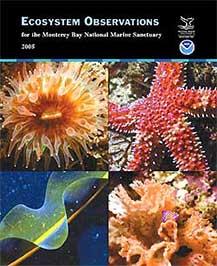MBNMS Ecosystem Observations 2005
.jpg) |
| Photo by Robert Schwemmer/NOAA |
On an island and at a time not so far away, I once had the pleasure of doing field biology work. On and off for several years in graduate school, I studied black abalone (Haliotis cracherodii) on Santa Cruz Island off Santa Barbara. For years, I also participated in many other research projects conducted by colleagues. I've never lost a personal interest in field biology and still find it one of the most rewarding activities I've done.
This edition of Ecosystem Observations provides me, personally—and you too, I hope—with the opportunity to experience the rewards of field biology work vicariously. That's not to say field work is easy, because it's not. It means climbing over stinky dead whales; queasy hours spent offshore in rough, windy conditions; or pulling on a cold wetsuit to wade into tidepools with the evening fog rolling in.
My personal curiosity of all things abalone is whetted a bit in the article inside about human impacts in the rocky intertidal. While kayaking in Monterey Bay several years ago, I began to wonder many things about the plethora of jellies in the bay: Where do they come from? How do they all get here together? Some answers to this, too, are inside. If I ever win the lottery, I'd volunteer to be a field biologist and join Scott Benson to study, and I hope save, leatherback turtles. There's hopeful news in this edition about this reptile, one of the most impressive large organisms on this planet.
I get so much out of these and all the other stories from our field biologist colleagues. Their contributions to Ecosystem Observations—the fruits of the many challenges involved in conducting field work—are inspiring to us all.
William J. Douros, Superintendent
NOAA's Monterey Bay National Marine Sanctuary
 |
A PDF version of this report is available here: ecoobs2005.pdf (1.5 MB) |
|
